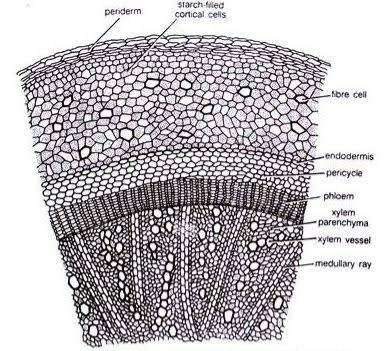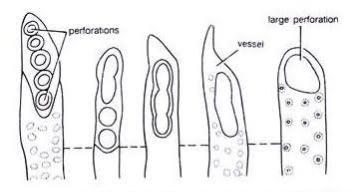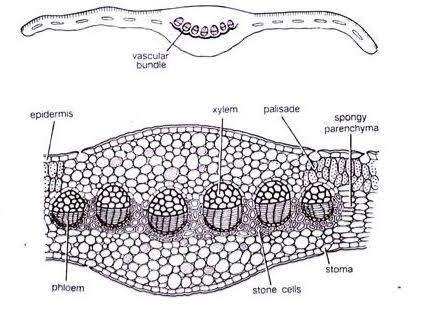Gnetophyta | Characters, Taxonomy, Morphology and Anatomy
| Kingdom | Plantae |
| Division | Gnetophyta |
| Class | Gnetopsida |
| Order | Gnetales |
| Family | Gnetaceae |
| Genus | Gnetum |
History and Origin of Gnetophyta / Gnetales
The fossil history of Gnetophyta or Gnetales is poorly known but Gnetales pollen occurs abundantly in Early Cretaceous sediments. In the Yixian Formation, remnants of Gnetales are relatively common and several taxa have been described. Pollen evidence suggests that the Gnetales as a modern group of gymnosperms closely related to the angiosperms.
Features of genetales show that it is like a bridge between gymnosperms and angiosperms. However, pieces of evidence from vascular anatomy strongly refuse the relationship between Gnetales and gymnosperms. There is similarity in the features, classification and affinities of Cycadofilicales and Gnetales. There are following features of Gnetales those confirm this relationship;
- 1) Presence of two cotyledons.
- 2) Vessels in the secondary wood.
- 3) Stamens are similar to angiosperms.
- 4) Bi-tegmic (Two coverings) ovules of Gnetales.
This group was present during the Triassic Period (about 252.2 million to 201.3 million years ago). Seventy (70) species from the genus Gnetum consist of a few trees and shrubs accompanied by several woody vine species. They can be difficult to identify because the distinguishable characteristics are often hidden up in the canopy and only the woody stem of the vine can be seen from ground level. However, their identification is quite easy at the time of flowering.
Occurrence of Gnetales
Gnetales are distributed in the tropical and humid regions of the world. Ephedra and Gnetum are found in the Eastern and Western Himalayas, western Africa, and South America. Five species of Gnetum are most common in India. These are;
- G. ula: It is a climber in nature with swollen nodes. It is commonly found in the Western Ghats near Khandala, forests of Kerala, Orissa, and Andhra Pradesh.
- G. contractum: A scandent shrub growing in Kerala, Nilgiri Hills, and Coonoor in Tamil Nadu.
- G. gnemon: A shrubby plant found in Assam
- G. montanum:A climber with smooth, slender branches, swollen at the nodes. It is common in Assam, Sikkim, and opther parts of Orissa.
- G. latifolium:A climber found in Andaman and Nicobar Islands.
Features of Gnetales
Following are the distinguishing features of gnetales;
- They are woody trees (G. gnemon), shrubs (small trees), or sometimes climbers (vines).
- Climbing species have branches of limited growth.
- They are evergreen trees.
- Leaves are simple, broad, scale-like, or strap-shaped with a network of veins.
- Leaves are arranged opposite to each other.
- Flowers are usually dioecious and rarely monoecious.
- Micro and megaspores are produced in distinct compound strobilus.
- Male gametes are non-motile.
- The female flower is with a single ovule covered with a single integument.
- The micropyle of the ovule is projected outward like a tube.
- The embryo is with two cotyledons.
- Flowers have distinct perianth and form cones (strobili).
- Insect pollination (Entemophilly) occurs.
- Flowers are arranged to form “Strobili”.
- Nectar is produced on top of the cone instead of a flower.
Classification and features of Gnetales
The group of gymnosperm includes almost 70 species within three genera i.e.;
- Gnetum
- Welwitschia
- Ephedra
Among these three groups, Ephedra differs from the other two groups in the structure of cone, wood, stem, and nodal anatomy. Morphology of fertile branch and position of the ovule in Ephedra suggest its relationship with Cordaites and Conifers. The Stomatal apparatus of Ephedra is also of a primitive type, different from that of the other two groups (i.e. Welwitschia and Gnetum).
See Also;
- How Are Peanuts Grown?
- Dallisgrass vs Crabgrass | Key Differences
- Esperanza Plant (Tecoma stans): Characteristics and Tips to Grow
- How Long Do Tulips Last?
Morphology of Gnetum
Blant body of Gnetum has roots, stems, and leaves.
Root
Freely branched tap root system is present in Gnetum. The mature roots show normal secondary growth.
Stem
Stem in the climbing type of species like G. montanum, G. ulla, G. latifolium, and scandent types (G. contractum) is supported with prominent joints. These joints help them to curl around the round stems of higher plants. Gnetum exhibits dwarf shoots (branches of limited growth) and long shoots (branches of unlimited growth).

Gnetum Stem
Leaf
Gnetum bears two types of leaves i.e. foliage leaves and scale leaves. This features of gnetales is called dimorphism. They resemble dicot leaves as they are large with broad lamina, oval-shaped with reticulate venation. About 9 to 10 foliage leaves, arranged oppositely in one plane on a dwarf shoot. The leaves are Exstipulate, shortly Petiolate with the entire margin.

A typical leaf of Gnetum
Anatomy of Gnetum
In Younger Roots
- Cortical cells have starch.
- Roots may be exarch and diarch (Angiospermic characteristics)
- 4-6 layers of pericycle
- Primary xylem is visible.
In Older Roots
- Primary xylem is indistinguishable due to secondary growth.
- It has tracheids, vessels & xylem parenchyma.
- Phloem consists of sieve cells.
- “Bars of Sanio” present in tracheids. It is absent in vessels.
- Vessels have simple or small multiseriate bordered pits.


1)
Gnetum Old Root showing Secondary Growth
In Young Stem
- The young stem resembles a typical dicotyledonous stem.
- It is roughly circular in outline.
- Sunken stomata are present
- Cortex is broad with Chlorenchymatous, Parenchymatous, and Sclerenchymatous regions respectively.
- Endodermis and pericycle are indistinguishable.
- Vascular bundle is conjoint.
- Xylem comprises tracheids and xylem vessels.
- Pholem comprises sieve cells and phloem parenchyma.

See Also;
In Old Stem
- 1) Stem in all species shows secondary growth
- 2) The primary cambium is ephemeral, i.e., short-lived.
- 3) Layer of sclerotic cells is present.
- 4) Secondary cambium form rings.
- 5) Secondary wood comprises tracheid and vessels.
- 6) Phloem sieve cells have perforated sieve plates.

Gnetum showing perforation in the end walls of the vessel
Leaves
- The cuticle covering on the epidermis
- Stomata are present on both lower and upper sides except in veins.
- Palisade mesophyll and spongy mesophyll are present.
- Stone cells and latex tubes are present in midrib regions.
- Vascular bundles are present in arch/curve firms in midrib regions.

Gnetum Upper leaf and Lower leaf
Power Point Presentation Gnetophyta / PPTs
I’m Dr Qaiser Maqsood (PhD), a dedicated researcher and expert in Biological Sciences, Gardening, Bio-Diversity, Ecology, and Environmental Sciences. I’m much concerned about Environmental Pollution, Climate Change, Plantation, Gardening, and Global Warming. My passion is to explore innovative solutions in all these fields.
Be aware that we have ONLY ONE EARTH. Protect it!!






